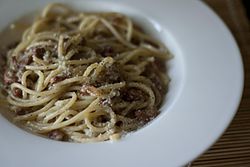
Pasta alla gricia
This article needs additional citations for verification. (May 2024) |

 | |
| Course | Primo (Italian pasta course) |
|---|---|
| Place of origin | Italy |
| Region or state | Lazio |
| Main ingredients | Guanciale, pecorino romano, black pepper |
Pasta alla gricia is a pasta dish originating in the Lazio region of Italy.[1]

Origin of the name
According to one hypothesis, the name of the dish derives from the Romanesco word gricio. In papal Rome, the grici were sellers of common foods,[2] and got this name because many of them came from Valtellina, at that time possession of the Swiss canton of Grigioni.[2] Pasta alla gricia then would mean pasta prepared with the simple ingredients (guanciale, pecorino romano, and black pepper) readily available at the local gricio.

Another theory about the origin of this dish claims that it was invented in the hamlet Grisciano, in the region of Lazio, near Amatrice. Buccini (2007) argues that this theory is more probably correct, citing a name spaghetti anna machiciana from the 1920s, referring to the neighboring region of Le Marche. The name would have started as alla grisciana, then modified to alla gricia to fit the occupational theme of carbonara and carrettiera.[3] It should be also noticed that in Amatrice as late as the 1960s, amatriciana sauce was prepared without tomato, therefore coinciding with gricia.[4] Due to this reason, gricia is also named "amatriciana bianca".

Pasta alla gricia is a member of a family of four basic Roman pasta dishes, along with bucatini alla amatriciana, spaghetti alla carbonara, and spaghetti alla carrettiera.[3]

See also
![]() Media related to Pasta alla gricia at Wikimedia Commons
Media related to Pasta alla gricia at Wikimedia Commons
![]() Pasta alla Gricia (Pasta with Guanciale) at the Wikibooks Cookbook subproject
Pasta alla Gricia (Pasta with Guanciale) at the Wikibooks Cookbook subproject

References
- ^ "Pasta alla Gricia". La Cucina Italiana. Retrieved 18 June 2024.
- ^ a b Ravaro (2005), p. 329
- ^ a b Buccini, Antony F. (2007). "On Spaghetti alla Carbonara and related Dishes of Central and Southern Italy". In Hosking, Richard (ed.). Eggs in Cookery: Proceedings of the Oxford Symposium of Food and Cookery 2006. Oxford Symposium. pp. 36–47. ISBN 978-1-903018-54-5.
- ^ Gosetti (1967), p. 686
Bibliography
- Zanini De Vita, Oretta; Fant, Maureen B. (2013). Sauces & Shapes: Pasta the Italian Way. New York: W. W. Norton & Company. ISBN 978-0-393-08243-2.
- Gosetti Della Salda, Anna (1967). Le ricette regionali italiane (in Italian). Milano: Solares.
- Ravaro, Fernando (2005). Dizionario romanesco (in Italian). Roma: Newton Compton. ISBN 9788854117921.
See what we do next...
OR
By submitting your email or phone number, you're giving mschf permission to send you email and/or recurring marketing texts. Data rates may apply. Text stop to cancel, help for help.
Success: You're subscribed now !
